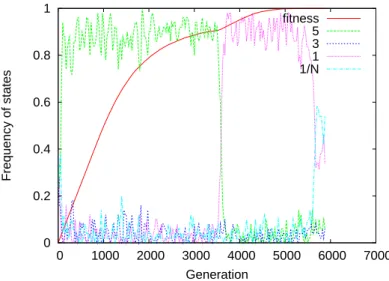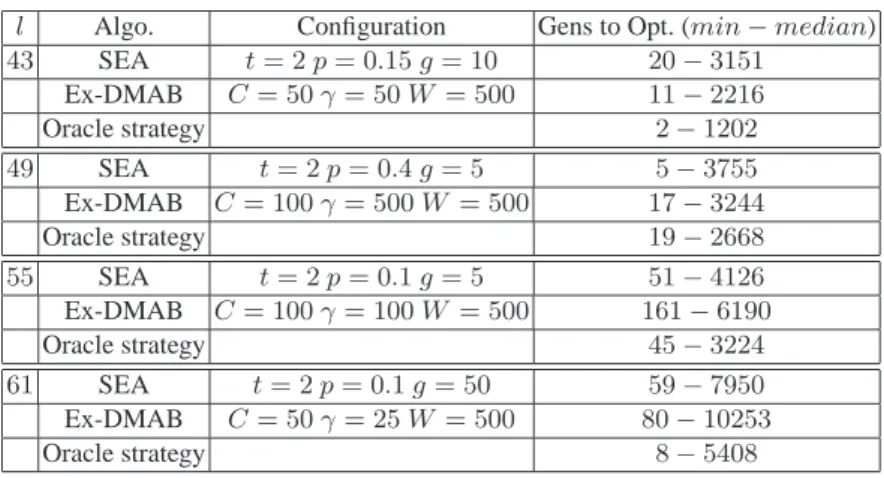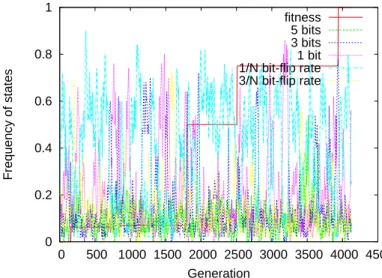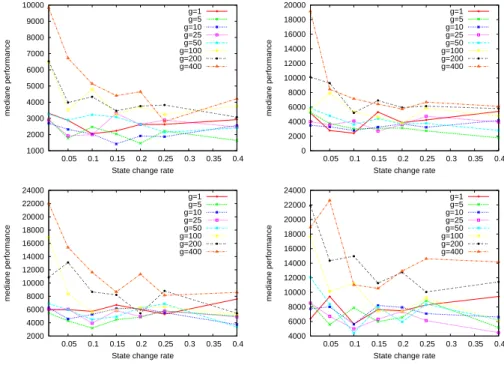HAL Id: hal-00518206
https://hal.archives-ouvertes.fr/hal-00518206
Submitted on 16 Sep 2010
HAL is a multi-disciplinary open access
archive for the deposit and dissemination of
sci-entific research documents, whether they are
pub-lished or not. The documents may come from
teaching and research institutions in France or
abroad, or from public or private research centers.
L’archive ouverte pluridisciplinaire HAL, est
destinée au dépôt et à la diffusion de documents
scientifiques de niveau recherche, publiés ou non,
émanant des établissements d’enseignement et de
recherche français ou étrangers, des laboratoires
publics ou privés.
States based evolutionary algorithm
Sébastien Verel, Philippe Collard, Manuel Clergue
To cite this version:
Sébastien Verel, Philippe Collard, Manuel Clergue. States based evolutionary algorithm. Workshop
selfstar at conference PPSN, Sep 2010, Krakow, Poland. �hal-00518206�
States based Evolutionary Algorithm
S´ebastien Verel1,2, Philippe Collard2, and Manuel Clergue2 1
INRIA Lille - Nord Europe, France 2
University of Nice Sophia-Antipolis, France.
Abstract. Choosing the suitable representation, the operators and the values of the parameters of an evolutionary algorithm is one of the main problems to design an efficient algorithm for one particular optimization problem. This additional information to the evolutionary algorithm generally is called the algorithm pa-rameter, or parameter. This work introduces a new evolutionary algorithm, States
based Evolutionary Algorithm which is able to combine different evolutionary
algorithms with different parameters included different representations in order to control the parameters and to take the advantage of each possible evolution algorithm during the optimization process. This paper gives first experimental arguments of the efficiency of the States based EA.
1
Introduction
The evolutionary algorithms are based on a search population of potential solutions of an optimisation problem. They iterate selection and replacement operators which favour the exploitation with stochastic operators which favour the exploration. Evolutionary Algorithm (EA) is a general framework which has been prove to be efficient on large optimisation classes of problems. The efficiency of the EA is lied in the ability to man-age the balance between the exploitation and the exploration of the search space. The stochastic or selection operators must be chosen and their parameters must be tuned in order to be efficient on the given optimisation problem. And so, one main difficulty for an engineer or optimisation researcher is to choose such operator and parameters. More generally, the representation or coding of solutions either the fitness function is also a key in the design of EA [7,8]. The problem could be difficult for one representation or fitness function and not for another one [9]. Generally this additional information to the evolutionary algorithm is called algorithm parameter, or simply parameter; and the problem to choose efficient parameter parameter setting. Two ways of parameters setting are possible: first one is off-line before the run, often called parameter tuning, and the second is on-line during the run, called parameter control. A nice review of this field of research has been made in the recent work of Lobo et al. [5]. The algorithm proposed in this work will use a parameter control method instead of parameter tuning method. The parameter of the States based EA will be modified on-line during the run by taking into account the current state of the search.
2
States based Evolutionary Algorithm
To define the State based EA (SEA), we supposed to haven evolutionary algorithms.
Each algorithmEAi is a stochastic population based operator defined on the search spacesS: ∀i ∈ [1, n], EAi : 2S → 2S
In a practical way, eachEAicould have his own representation of solutions, but also his own selection operator, variation operators (mutation and crossover), and parameter settings. The EA has only to be defined whatever the population size.
A state of a solution is an integer number between[1, n] added to the solution which
indicates the EA applied on the solution. If different representations and fitness func-tions are used for eachEAi, we suppose that the fitness of a solution does not change when the state changes:∀i, j, fi(s) = fj(stateM utij(s)) where stateM utij is an operator which changes the state of solutions from i to j. The main principle of the
SEA is to control the population size of eachEAiaccording to the fitness values of the actual solutions with a classical selection operator.
The total search population size is constant during the run and given by a parameter. The number of statesn is also a parameter of the algorithm. The initialization of the
population is an operator which first choose the state of each solution, and then apply the initialisation operator of the solutions state. One iteration of the algorithm is the succession of the stochastic population based operators: selection, split,EAi, merge, state mutation, and replacement. The operator of selection choose a population from a population included inS of solutions with their state. It selects the solutions
accord-ing to their fitness but not directly accordaccord-ing to their state. The splittaccord-ing operator splits the population fromS into n sub-populations in Si. Each sub-population is composed with all the solutions in the same state. Then, the EA corresponding to the solutions state is applied on each sub-population. The EAs are independent, and does not take into account the result of the other EAs. The sizes of each sub-populations vary as they are not defined by a parameter of the algorithm but by the number of solutions in each state. This stage could be parallelized. The merging operator is a simple operator which merges then sub-populations from Si into one population ofS. After, a
oper-ator of state mutation is applied which possibly change only the state of solutions. If
a solution changes from search spacek to search space l, the solution is moved with
the state change operator stateM utationkl. Remember that the fitness of solutions is maintained by a state change. It is possible to have state mutation operators which changes the state of solutions in the same way for all solutions in the same states in-dependently of the solutions in other state. In that case, it is possible to parallelize this stage. Otherwise, it is not possible when for example, the operator changes the state of a fixed number of solutions. The operator of replacement is the classical operator which creates a new population for the next iteration according to the population from EAs and the old population of solutions. Again, the replacement does not take into account the states of solutions. The algorithm 1 is the algorithm of State based EA.
The selection of the right state is indirect and it is made only with the fitness of the actual solutions. If the solutions of a given state are better, we hope that the selection operator choose more often such solutions, and as a consequence, the state population size should increase. Indirectly, the selection operator puts more solutions in the rights state.
Algorithm 1 States based evolutionary algorithm.
population ← initialisation()
while continue(population) do
selectedP op ← selection(population) (pop1, . . . , popn) ← split(selectedP op) for all i ∈[1, n] do
popi←EAi(popi) end for
mergedP op ← merge(pop1, . . . , popn)
child ← stateMutation(mergedP op) population ← replace(child, population)
end while
3
Experimental study
To conduct experimental study of the SEA, we test the algorithm on two classical prob-lems in EA: OneMax and long k-path probprob-lems. Those probprob-lems were used in recent works of Fialho et al. [1] [2] which propose a parameters control methods, the average and the extreme Dynamic Multi-Bandits (resp. avg-DMAB and ex-DMAB). It allows the comparison of performances between the SEA and the exDMAB. The authors takes
(1+λ)−EA with λ = 50. To compare to this work, we use evolution algorithms without
crossover, and using one of the same four mutation operators: the standard1/l bit-flip
operator (every bit is flipped with the binomial distribution of parameter1/l where l is
the length of the bit-strings), and the1−bit, 3−bit, and 5−bit mutation operators (the b−bit mutation flips exactly b bits, uniformly selected in the parents). So there are four
evolutionary algorithms denotedEAi i = 1..4. The population size of EAiisλi. At each iteration ofEAi, the best solution is selected from theλisolutions in the parent population. From this best solution,λisolutions are created using the mutation operator. The generational replacement with elitism is used: all the offspring solutions replace the parent ones keeping the best solution founded in the parent population. ThoseEAiare closed to(1 + λ)−EA.
The SEA controls the population size of the fourEAi. The total population size is
λ = λ1+ λ2+ λ3+ λ4= 50. The selection method used is tournament selection of size
t, and the replacement method is generational with elitism. The state mutation operator
changes a state at random with a ratep. Each EAiis running with the number of gen-erationg. The meta-parameters of the SEA has been computed off-line by a Design Of
Experiments campaign. The tournament selection is used for the state selection operator with the tournament sizet ∈ {2, 3, 5}. The mutation operator changes the state of
solu-tions randomly with the state mutation ratep ∈ {0.001, 0.01, 0.05, 0.1, 0.15, 0.2, 0.25, 0.4}.
The number of generations of eachEAiisg ∈ {1, 5, 10, 25, 50, 100, 200, 400}.
3.1 One Max problem
The oneMax problem, the ”drosophila” of evolutionary computation, is a unimodal problem defined on binary strings of size l. The fitness is the number of ”1” in the
bit-string. In the experiments, the length of the bit strings isl = 104
. In all reported experiments, the initial solution is set to(0, . . . , 0).
The table 1 shows the performances of the SEA compared to the ones of extreme and average DMAB (ex-DMAB and avg-DMAB) and oracle strategy reported from [1]. The performance of SEA are better than the average-DMAB and worst than the extreme-DMAB according to the non-parametric tests of Wilcoxon and Kolmogorov-Smirnov (p-values are under10−7). The figure 3 shows a typical example of dynamics of the SEA. Due to the difference of the number of iteration between the200 runs, we
show the run which gives the median performance (5891 generations). At the beginning,
the largest sub-population quickly becomes the one of the5-bit mutation operator. This
operator is the best one at this stage. Around the generation3600, the population size
of the1-bit mutation operator dominates the other ones. We can notice that the 3-bit
mutation operator never able to dominate the others. The3-bit mutation is the operator
with best average fitness gain for fitness values between6580 and 8400. Nevertheless,
the fitness gain of the5 and 3 bit mutations are close. The difference of performance
between SEA and ex-DMAB could be explain by the relative lack of the3 bit mutation
operator. At the end, the1/l bit-flip mutation has a population size around those of the 1-bit mutation. Indeed, this two operators have nearly the fitness gain for high fitness
value.
Table 1. Average and standard deviation number of generations to the optimal solution
out of200 independent (for SEA) runs using the optimal meta-parameters
Algo. Configuration Gens to Opt. (avgsd) SEA t= 2 p = 0.05 g = 25 6076804 avg-DMAB C= 10 γ = 25 W = 50 7727642 Ex-DMAB C= 1 γ = 250 W = 50 5467513
Oracle strategy 5069292
The figure 2 allows to study the robustness of the meta-parameters of the SEA. It shows the average performances of the SEA computed off-line during the Design Of Experiments campaign according to the tournament size t, the state mutation rate p,
and the number of generationsg. The average performance is relatively independent of
the tournament size. The number of generations and the state mutation rate have more impact on it. Extreme values of the number of generations (1, 200, and 400) do not give
good performances. According to the state mutation rate, the performances increases tillp around 0.05 or 0.1, and decreases after 0.1. For the oneMax problem with l = 104 robust parameters seems to bet ∈ [2, 5], p ∈ [0.05, 0.1], and g ∈ [25, 50]. In this case,
the window of robust meta-parameters is quite large.
3.2 Long k-path problem
The long path problem [4] has been introduced to show that a problem instance can be difficult to solve for a hill-climber-like heuristic even if the search space is unimodal,
0 0.2 0.4 0.6 0.8 1 0 1000 2000 3000 4000 5000 6000 7000 Frequency of states Generation fitness 5 3 1 1/N
Fig. 1. Example of run of the SEA witht = 2, p = 0.05 and g = 25 on the oneMax
problem: fitness, the relative number of solutions in each states are given. The chosen example gives the median performance (gens to opt5891).
i.e. a fitness landscape where the global optima is the single local optima. For such a
problem, a hill-climber guarantees to reach the global optimum, but the length of the path to get it is exponential in the dimension of the search space. As a consequence, a hill-climbing-based heuristic cannot solve the problem in polynomial time. The ‘path length’ takes then place in the rank of problem difficulty, on the same level as multi-modality, ruggedness, deceptivity, etc. The long path problem [10] [3] can be solved in a polynomial expected amount of time for a(1 + 1)−EA which is able to mutate more
than one bit at a time. This(1 + 1)−EA can take some shortcuts on the outside of the
path so that it makes the computation more efficient.
Like in the work of Fialho, an additional mutation operator, the3/l bit-flip, has
been added to the operator set. The table 2 shows the performances of the SEA and ex-DMAB. The minimum and the median of number generations to optimum over200 runs
are presented. The performances for all algorithms are highly variables from one sample to another. We perform the two non-parametric tests of Wilcoxon (W) and Kolmogorov-Smirnov (KS). For l = 43, the performances of ex-DMAB are better according to
KS with confidence1%, but only at confidence 5% for W test. For l = 49, the two
algorithms obtain similar results according both test W and KS. For the problems with
l = 55 and l = 61, the SEA outperforms the ex-DMAB according the statistical tests
(p-values are under10−4). It is difficult to have a clear conclusion from those experiments due to the large randomness of the results, but it seems that SEA is able to have better performances than extreme value based DMAB on the largest instance of long3-path
5500 6000 6500 7000 7500 8000 8500 9000 9500 10000 0 0.05 0.1 0.15 0.2 0.25 0.3 0.35 0.4 avg performance
State change rate g=1 g=5 g=10 g=25 g=50 g=100 g=200 g=400 5500 6000 6500 7000 7500 8000 8500 9000 9500 10000 0 0.05 0.1 0.15 0.2 0.25 0.3 0.35 0.4 avg performance
State change rate g=1 g=5 g=10 g=25 g=50 g=100 g=200 g=400 5500 6000 6500 7000 7500 8000 8500 9000 9500 10000 0 0.05 0.1 0.15 0.2 0.25 0.3 0.35 0.4 avg performance
State change rate g=1 g=5 g=10 g=25 g=50 g=100 g=200 g=400
Fig. 2. Average performance of the SEA on the oneMax problem withl = 104 com-puted off-line during the Design Of Experiments campaign according to the state mu-tation ratep, the number of generation g, and tournament size t. From top to bottom
tournament sizet = 2, 3, 5. Average on 50 independent runs.
Table 2. Minimum and median number of generations to the optimal solution out of
200 independent runs using the optimal meta-parameters
l Algo. Configuration Gens to Opt. (min − median) 43 SEA t= 2 p = 0.15 g = 10 20 − 3151 Ex-DMAB C= 50 γ = 50 W = 500 11 − 2216 Oracle strategy 2 − 1202 49 SEA t= 2 p = 0.4 g = 5 5 − 3755 Ex-DMAB C= 100 γ = 500 W = 500 17 − 3244 Oracle strategy 19 − 2668 55 SEA t= 2 p = 0.1 g = 5 51 − 4126 Ex-DMAB C= 100 γ = 100 W = 500 161 − 6190 Oracle strategy 45 − 3224 61 SEA t= 2 p = 0.1 g = 50 59 − 7950 Ex-DMAB C= 50 γ = 25 W = 500 80 − 10253 Oracle strategy 8 − 5408
The figure 3 displays a typical example of run of the SEA on the long3-path with l = 55. Again, we choose to show the one with the median performance (4126
gen-erations). The search dynamics on long path problems is different from the one on the oneMax problem. There is no large stage where the number of solution in one state dominates the others. Even the larger sub-population size variation is not regular, and draws a lot of random jumps. Those stochastic variations of sub-population size seem to appear all along the search process, there is no difference between the beginning and the end of the run. We can notice that the sub-population of the1/l bit-flip mutation
operator is more often the larger one. For this typical run, the1/l bit-flip mutation is
the larger one during60% of the total number of generation, the 1-bit mutation 21%
of times, the3-bit mutation 12%, the 3/l bit-flip mutation 5%, and the less used is the 5-bit mutation with 1% of the total number of generations. For the most used mutation
operator, the sub-population size is around55% of the total number of solutions λ. It
also means that the other mutations are always applied during the run.
0 0.2 0.4 0.6 0.8 1 0 500 1000 1500 2000 2500 3000 3500 4000 4500 Frequency of states Generation fitness 5 bits 3 bits 1 bit 1/N bit-flip rate 3/N bit-flip rate
Fig. 3. Example of run of the SEA witht = 2, p = 0.1 and g = 5 on the long 3-path
problem withl = 55: fitness, the relative number of solutions in each states are given.
The chosen example gives the median performance (gens to opt4126).
The robustness of the meta-parameters of the SEA is also study for the long path problems. The figure 2 shows the median generation to reach the global optimum com-puted off-line during the Design Of Experiments campaign according to the state muta-tion ratep, and the number of generations g. Only the tournament size t = 2 is shown.
The similar performances are obtained for tournament size3 and 5. A larger number
of generation for theEAi gives bad performances, andg must be lower than 100. For this problemg = 1 can be used in contrary of the oneMax problem. The state mutation
rate seems to be more robust for this problem. Even if a rate around0.1 improves the
performances of the SEA. The large set of parameters values gives good performances. The meta-parameters of the SEA are more robust for the long path problems than for the oneMax problem.
1000 2000 3000 4000 5000 6000 7000 8000 9000 10000 0.05 0.1 0.15 0.2 0.25 0.3 0.35 0.4 mediane performance
State change rate g=1 g=5 g=10 g=25 g=50 g=100 g=200 g=400 0 2000 4000 6000 8000 10000 12000 14000 16000 18000 20000 0.05 0.1 0.15 0.2 0.25 0.3 0.35 0.4 mediane performance
State change rate g=1 g=5 g=10 g=25 g=50 g=100 g=200 g=400 2000 4000 6000 8000 10000 12000 14000 16000 18000 20000 22000 24000 0.05 0.1 0.15 0.2 0.25 0.3 0.35 0.4 mediane performance
State change rate g=1 g=5 g=10 g=25 g=50 g=100 g=200 g=400 4000 6000 8000 10000 12000 14000 16000 18000 20000 22000 24000 0.05 0.1 0.15 0.2 0.25 0.3 0.35 0.4 mediane performance
State change rate g=1 g=5 g=10 g=25 g=50 g=100 g=200 g=400
Fig. 4. Median generation (over50 independent runs) to optimal solution on the long
3-path problems computed off-line during the Design Of Experiments campaign accord-ing to the state mutation rate. Tournament size ist = 2. From top-left to bottom-right l = 43, 49, 55, 61.
4
Discussion
In this paper we have presented the State based EA (SEA) as a general framework which allows to choose efficient parameter setting on-line during the run. Most often, such approaches work with measure of performance on the operator used as evolvability of solution or diversity of the population. The SEA proposes a new method which uses directly the distribution of fitness of solutions produced by the operator to implicitly select the parameters. Nevertheless, it is rather an adaptive method than an auto-adaptive method because it manages two kind of dynamics: one to evolve the solutions, and one to evolve the parameters of the first ones. The rate of evolution of EA parameters
is different than those of the meta-parameters. A crucial point is to well adjust the two dynamics in order they work in concordance. Like the bandit methods used in previous works, the SEA uses an exploitation component (the global selection) and an exploration component (the state mutation). The way to manage the computational cost, i.e. the number of evaluations, between the operators (or evolutionary algorithms) is different. In the AOS methods, one operator (or optimization algorithm) is used at each generation, and the method controls the number of generation for each operator during the run. In the SEA, several evolutionary algorithms can be used at the same time, and the method controls the sub-population size of each algorithm. The SEA is more parallel and the AOS more sequential.
The performance of the SEA should clearly depends on the balance between the exploitation and the exploration components. So, theoretical works must be done to analyse and coordinate this balance. New experimental studies must be conducted on others problems to understand the advantageous and the limits the SEA. The oneMax and long path problems are unimodal problems where the population based algorithms does not perform better than algorithms like(1 + λ)-ES. So, next step will be study
the performance of the SEA on problems such as SAT problems, and then compare the SEA with the extreme Compass Dynamic Multi-Armed Bandit [6].
Acknowledgments
The authors would thank Alvaro Fialho for his grateful help.
References
1. ´Alvaro Fialho, Luis Da Costa, Marc Schoenauer, and Mich`ele Sebag. Dynamic Multi-Armed Bandits and Extreme Value-based Rewards for Adaptive Operator Selection in Evolutionary Algorithms. In Learning and Intelligent Optimization (LION 3), Trento Italie, 2009. BEST PAPER AWARD I.: Computing Methodologies/I.2: ARTIFICIAL INTELLIGENCE/I.2.8: Problem Solving, Control Methods, and Search.
2. ´Alvaro Fialho, Marc Schoenauer, and Mich`ele Sebag. Analysis of adaptive operator selection techniques on the royal road and long k-path problems. In GECCO ’09: Proceedings of the
11th Annual conference on Genetic and evolutionary computation, pages 779–786, New
York, NY, USA, 2009. ACM.
3. Josselin Garnier and Leila Kallel. Statistical distribution of the convergence time of evolu-tionary algorithms for long-path problems. IEEE Trans. Evoluevolu-tionary Computation, 4(1):16– 30, 2000.
4. Jeffrey Horn, David E. Goldberg, and Kalyanmoy Deb. Long path problems. In PPSN, volume 866 of LNCS, pages 149–158. Springer, 1994.
5. Fernando G. Lobo, Cl´audio F. Lima, and Zbigniew Michalewicz, editors. Parameter Setting
in Evolutionary Algorithms, volume 54 of Studies in Computational Intelligence. Springer,
2007.
6. Jorge Maturana, ´Alvaro Fialho, Frederic Saubion, Marc Schoenauer, and Michele Sebag. Extreme compass and dynamic multi-armed bandits for adaptive operator selection. In
CEC’09: Proceedings of the IEEE International Conference on Evolutionary Computation,
7. Franz Rothlauf and David E. Goldberg. Representations for Genetic and Evolutionary
Algo-rithms. Physica-Verlag, 2002.
8. Franz Rothlauf and David E. Goldberg. Redundant representations in evolutionary compu-tation. Evol. Comput., 11(4):381–415, 2003.
9. Jonathan Rowe, Darrell Whitley, Laura Barbulescu, and Jean-Paul Watson. Properties of gray and binary representations. Evol. Comput., 12(1):47–76, 2004.
10. G¨unter Rudolph. How mutation and selection solve long path problems in polynomial ex-pected time. Evolutionary Computation, 4(2):195–205, 1996.




